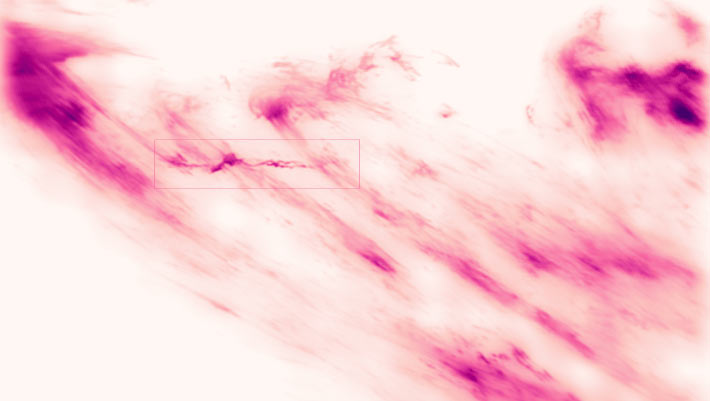To make these high-resolution images and movies, astronomers from NSF’s National Solar Observatory and New Jersey Institute of Technology developed a new ‘coronal adaptive optics’ system that removes blur from images caused by the Earth’s atmosphere.
This image is a snapshot from a 16-minute time-lapse movie showing the formation and collapse of a complexly shaped plasma stream traveling at almost 100 km per seconds in front of a coronal loop system. This is likely the first time such a stream, which the scientists refer to as plasmoid, has been observed, leaving them wondering about the physical explanation of the observed dynamics. This image was taken by the Goode Solar Telescope at Big Bear Solar Observatory using the new coronal adaptive optics system Cona. The image shows the hydrogen-alpha light emitted by the solar plasma. The image is artificially colorized, yet based on the color of hydrogen-alpha light, and darker color is brighter light. Image credit: Schmidt et al. / NJIT / NSO / AURA / NSF.
The solar corona is the outermost layer of the Sun’s atmosphere, visible only during a total solar eclipse.
It has long intrigued astronomers due to its extreme temperatures, violent eruptions, and large prominences.
However, turbulence in the Earth’s atmosphere has caused image blur and hindered observations of the corona.
“The turbulence in the air severely degrades images of objects in space, like our Sun, seen through our telescopes. But we can correct for that,” said Dr. Dirk Schmidt, an adaptive optics scientist at the National Solar Observatory.
The Cona — the adaptive optics system responsible for the new images — compensates for the blur caused by air turbulence in the Earth’s atmosphere.
This technology was funded by NSF and installed at the 1.6-m Goode Solar Telescope (GST) at Big Bear Solar Observatory in California.
“Adaptive optics is like a pumped-up autofocus and optical image stabilization in your smartphone camera, but correcting for the errors in the atmosphere rather than the user’s shaky hands,” said Dr. Nicolas Gorceix, an optical engineer and chief observer at Big Bear Solar Observatory.
Among the team’s remarkable observations is a movie of a quickly restructuring solar prominence unveiling fine, turbulent internal flows.
Solar prominences are large, bright features, often appearing as arches or loops, extending outward from the Sun’s surface.
A second movie replays the rapid formation and collapse of a finely structured plasma stream.
“These are by far the most detailed observations of this kind, showing features not previously observed, and it’s not quite clear what they are,” said New Jersey Institute of Technology’s Professor Vasyl Yurchyshyn.
“It is super exciting to build an instrument that shows us the Sun like never before,” Dr. Schmidt said.
A third movie shows fine strands of coronal rain — a phenomenon where cooling plasma condenses and falls back toward the Sun’s surface.
“Raindrops in the Sun’s corona can be narrower than 20 km,” said Dr. Thomas Schad, an astronomer at the National Solar Observatory.
“These findings offer new invaluable observational insight that is vital to test computer models of coronal processes.”
Another movie shows the dramatic motion of a solar prominence being shaped by the Sun’s magnetism.
“The new coronal adaptive optics system closes this decades-old gap and delivers images of coronal features at 63 km resolution — the theoretical limit of the 1.6-m Goode Solar Telescope,” said Dr. Thomas Rimmele, chief technologist at the National Solar Observatory.
“This technological advancement is a game-changer, there is a lot to discover when you boost your resolution by a factor of 10,” Dr. Schmidt said.
The team’s results are described in a paper published today in the journal Nature Astronomy.
_____
D. Schmidt et al. Observations of fine coronal structures with high-order solar adaptive optics. Nat Astron, published online May 27, 2025; doi: 10.1038/s41550-025-02564-0
https://www.sci.news/astronomy/solar-corona-13940.html





